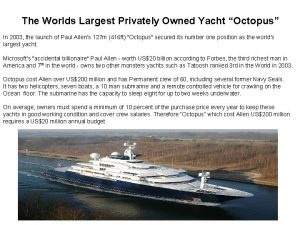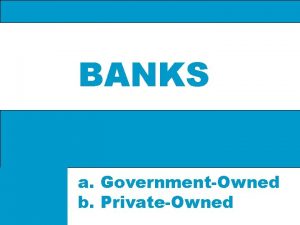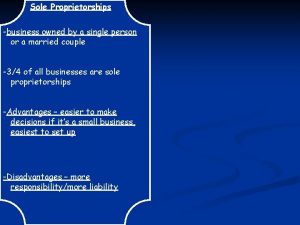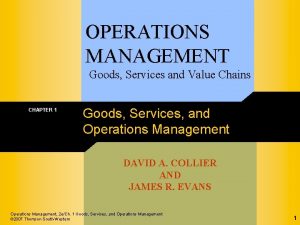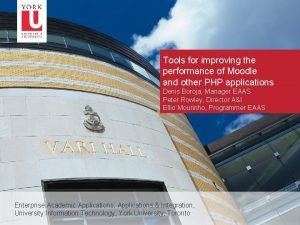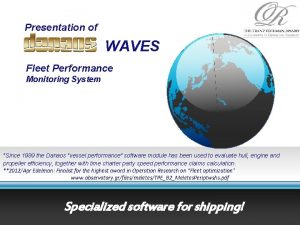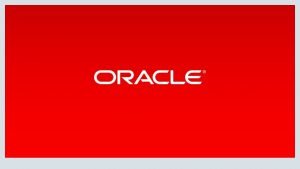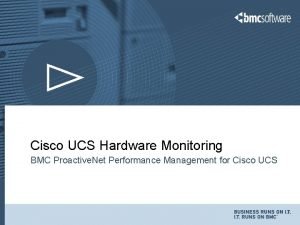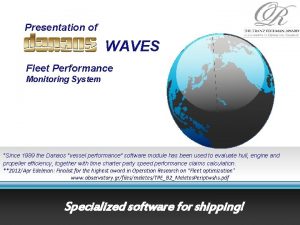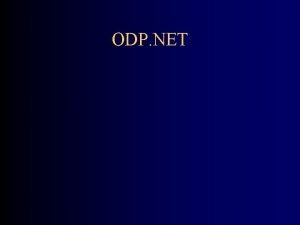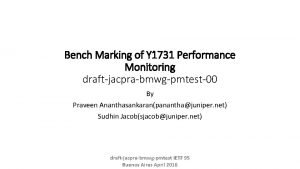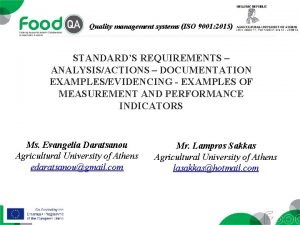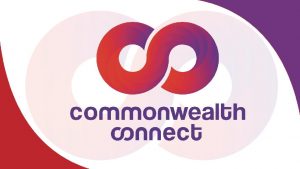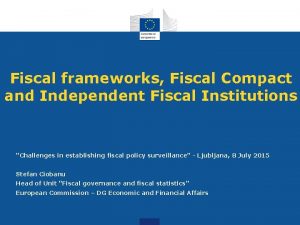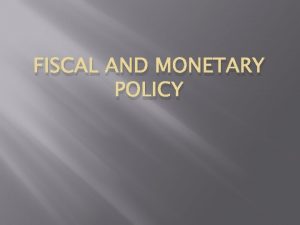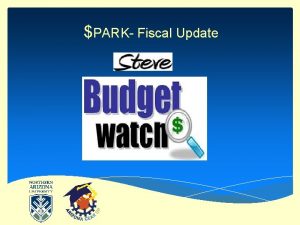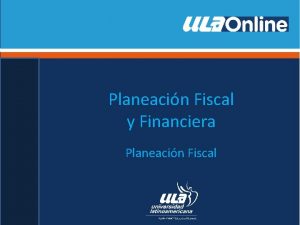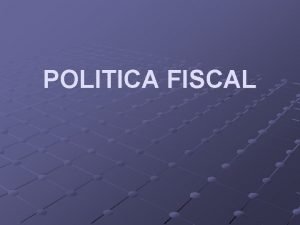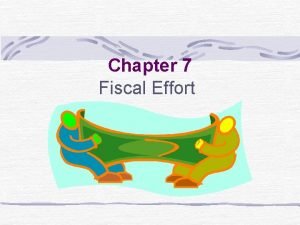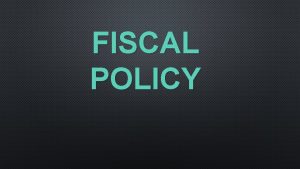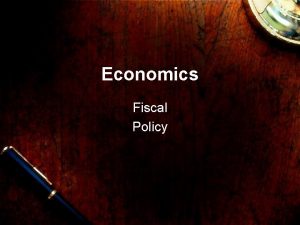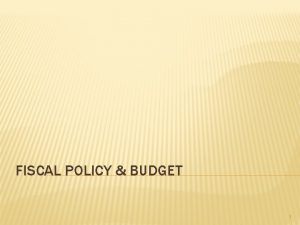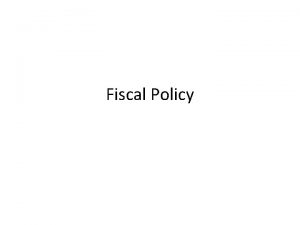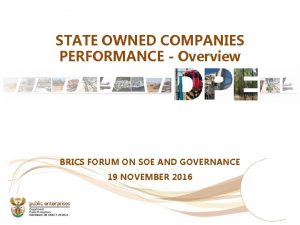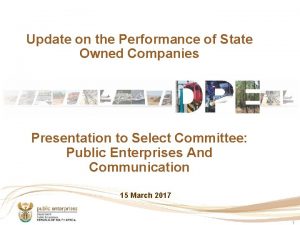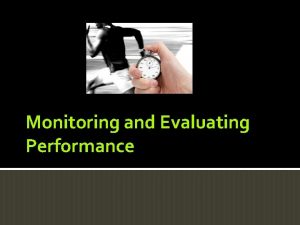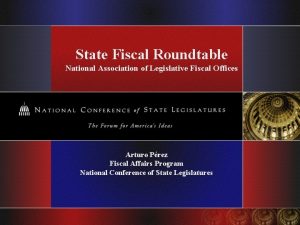Fiscal Risks and Performance Monitoring of State Owned

































- Slides: 33

Fiscal Risks and Performance Monitoring of State Owned Enterprises (SOEs) Andrei Busuioc, Senior Financial Management Specialist, The World Bank CFRR April 12, 2017, Bishkek, Kyrgyz Republic PEMPAL 2017 BCOP Plenary Meeting: TOOLS FOR FISCAL MANAGEMENT

Objective of the session: Governance and fiscal risks of SOEs Performance monitoring of State Owned Enterprises, with a focus on what information is needed to assess and monitor fiscal risks

Outline » Importance of SOEs & key elements of their good governance » Key elements of governance relevant for fiscal risks from SOEs » Fiscal risk from SOEs 3

Importance of SOEs & key elements of their good governance

Source: World Bank Group’s Competition Policy Team elaboration based on the Note by the European Union, Roundtable on Competition Neutrality OECD, 2015. 5 5

SOEs in emerging markets Source: Musacchio et al (2014) 6

Role of SOEs in Europe and Central Asia region (1) SOEs are significant contributors to GDP: In the main sectors: • • • Energy Transport Telecommunications Financial sector General manufacturing 7

Role of SOEs in Europe and Central Asia region (2) SOEs are among largest employers: 8

SOEs and the twin goals CLIENT DEMAND • Performance & transparency of SOE operations • Fiscal risk management • Assessment of market distortions and resource allocation • SOFI support to fin. inclusion, SMEs and infrastructure financing • Impact on poverty of SOE operations • When and how to bring in private sector From EFI SOE WG Pres. July 2016 SOE PERFORMANCE TWIN GOALS • Quality service delivery to citizens and businesses End extreme Poverty • Financial and fiscal sustainability Promote shared prosperity • Level playing field and competitive neutrality 9

Autonomy versus Accountability A strong governance framework gives SOEs autonomy, while ensuring their accountability to the general public Managerial Autonomy Financial Accountability • • Financial discipline Fiscal discipline Board independence Identification and reimbursement for PSOs Corporatization Labor issues (hiring/firing, compensation) Procurement • • • Performance monitoring Financial reporting Non-financial reporting External audits Control environment: ownership entity, board of directors, audit committee, internal audit unit; management 10

SCHEMATIC REPRESENTATION: OECD GUIDELINES - 2015 Government & Central Administration Rationale for State Ownership (1) SOEs in the marketplace (3) Ownership Function (2) (Legal and regulatory framework) Board of Directors (7) Transparency (6) • • Publication of aggregate Reports Publication of External Audits SOE Equal Treatment of Shareholders and others investors (4) Stakeholders relations and responsible 11 business (5)

Framework for SOE Governance A strong SOE governance framework safeguards the interests of citizens, as the ultimate owners of SOEs, through appropriate Levels of Reform mechanisms at the entity, government, and institutional levels Financial and Fiscal Discipline Board of Directors Transparency, Disclosure & Controls SOE (entity-level) Thematic Performance Monitoring State (government level) State’s Ownership Role Institutional Framework Legal and Regulatory framework Equal Treatment of Shareholders 12

Key elements of governance relevant for fiscal risks from SOEs

Performance Monitoring Key principles Comments Central role of the ownership entity(ies) Policymaking entities and regulatory agencies also have a monitoring role Broad scope: financial, operational and ESG aspects of performance Holistic view/ integrated thinking Monitoring system should be consistent with the SOEs’ own performance management Requires well-trained staff with industry knowledge and IT infrastructure Entails formal processes (setting goals, performance agreements, reporting, providing assurance, etc. ) and informal exchanges with the SOEs Importance to maintain balance between the two 14

Financial and Fiscal Discipline Key principles Comments Reduce/phase out State’s direct and indirect financial support Identify and cost out public policy (non-commercial) objectives and compensate the SOEs for these Monitor and manage the fiscal burden and risk SOE impose on the State Ex-ante controls may exacerbate moral hazard Markets can play a disciplining role (e. g. , bond issuance) See separate discussion on fiscal risk associated with SOEs 15

Financial Accountability, Controls and Transparency (1/2) Key principles Comments SOEs should observe high standards of corporate financial reporting (preferably the International Financial Reporting Standards) • IFRS designed with a focus on investors, therefore very challenging • Some advocate use of public sector standards Timeliness SOEs often report very late Annual and interim reporting SOEs often only report once a year Growing focus on non-financial reporting No unique global standard Strong internal controls and internal audit function reporting to the Board (or its’ Audit Committee) State auditor can play a useful role in this area Financial statements should be audited and nonfinancial information independently reviewed State auditor in most cases not able to perform financial audit of SOEs (+ the audit should be equivalent to any private sector entity) 16

Financial Accountability, Controls and Transparency (2/2) Key principles Comments Information should be easily accessible to the public (e. g. , websites or central public registers of financial statements) Audit committee plays a key role in ensuring the integrity or the reporting and audit processes, and of the internal control/risk management systems Importance of interactions with internal and external auditors State should report each year on the SOE sector as a whole and how it fulfilled its role as owner Many States do not report on their ownership role A key enabling dimension of governance 17

Summary – why good governance of SOEs matters A good corporate governance system is associated with a number of benefits for all companies, whether private or state owned: » better access to external finance » larger investments and lower costs of capital » higher growth and valuation » greater employment creation and growth » improved operational performance and more efficient management » reduced risk of corporate crises and scandals » less risk for public finances » further reduce poverty and income inequality Taken together, these benefits can boost the efficiency of SOEs and economy as a hole, make transactions among companies more competitive and transparent; result in more efficient allocation of resources; reduce fiscal burden and fiscal risk of SOEs; lead to greater public and private investment in critical sectors, contribute to competitiveness and growth; reduce vulnerabilities in the financial system and promote financial sector development. Implementing many of the good practices will be a challenge for most countries in the short-term; the solutions should be sequenced in time to achieve good progress over long term 18

Fiscal risk from SOEs

Defining fiscal risks from SOEs » As defined by the IMF - fiscal risks are possible deviations of fiscal outcomes from what was expected at the time of the budget or other forecast » Fiscal risks are defined here as factors outside government control that can cause fiscal outturns to differ from their initial forecasts. » State-owned enterprises (SOEs) are a potentially significant and common source of fiscal risks, with government bailouts of troubled SOEs costing 3 percent of GDP on average and 15 percent of GDP in the most extreme cases. (IMF, June 2016, ANALYZING AND MANAGING FISCAL RISKS: BEST PRACTICES) 20

Indicators of fiscal risks » SOEs: one of 7 main sources of fiscal risk » Contingent liab. realization 1990 and 2014: Contingent Liability Number of Events with Costs Fiscal Cost Average % of GDP Maximum Financial Sector Legal Subnational SOEs Natural Disaster Corporate PPPs Other Total 91 9 13 32 65 7 8 5 230 82 9 9 31 29 6 5 3 174 Source: Bova and others (2016), cited in IMF (2016) 9. 7 7. 9 3. 7 3. 0 1. 6 1. 7 1. 2 1. 4 6. 1 56. 8 15. 3 12. 0 15. 1 6. 0 4. 5 2. 0 2. 5 56. 8 21

Fiscal risk and fiscal discipline » The economic performance of SOEs has a direct bearing on the government budget. Healthy companies - valuable assets, BUT lossmaking or overly indebted firms - liabilities - may require interventions capital or other assistance (reliable information is key!) » Where corporate governance and institutional oversight are weak SOEs can generate significant fiscal risks - subsidies from the budget, generating low rates of return with lower dividends, paying less in taxes and incurring debts that the state will need to cover » Legal form of SOEs can also be a risk in itself! – sometimes quasi-fiscal activities or implementing public policy objectives can be a source of risk 22 22

Links between state ownership in SOEs and government's budgetary position – an example from Estonia » Estonia is a Member States with a relatively high share of state participation in the capital of public and private companies, respectively 19. 0% and 0. 2% of GDP » The annual accounts of the state provide a good example of transparency by listing all companies with the participation of the central government, together with the state's share and companies' financial information » The companies in state ownership have predominantly been profitable; dividends received by government improved budgetary position by 0. 9% of GDP on average between 2005 and 2014 - a stable source of income for the budget; The national airline Estonian Air (97% owned by state) - difficulties in recent years - government injected capital of EUR 17. 9 m (0. 1% of GDP) in 2010 and EUR 30 m (0. 2% of GDP) in 2011 - to restore the stock capital; these transactions were considered as expenditure from the point of view of public finances » In addition, a debt cancellation towards Estonian Air was decided by the government in 2014, reducing general government's surplus in that year by EUR 37 m (0. 2% of GDP). The company went into liquidation in late 2015 Source: SOEs in the EU Lessons Learnt and Ways Forward in a Post-Crisis Context. July 2016, EC. 23 23

Types of fiscal risks form SOEs » Static and dynamic risk » Static - size of SOEs, financial position, current risk » Dynamic – more forward looking, trends, loosing revenues/profits/fiscal position/taxes/dividends – what can happen? » How to explore fin statements – where to get information? » Reliability of information! » Risk management – scenario analysis » Calibration – measuring risks » Contingent liabilities, provisions 24

Indicators of fiscal risks -SOEs as source of fiscal risk § § § § “Bail out” of SOE, through fresh capital contribution, debt equity swap, loan write off, etc. Liquidation costs Retrenchment programs paid for by the State; transfer of SOE personnel to the State Decline in dividend revenue Shortfall in revenue from divestiture Lower tax revenues Loss of commercial revenues for the State (e. g. , rental of facilities) Etc. 25

Indicators of fiscal risks - Static View What to look for Source Reduced ability to distribute dividends Financial statements (gearing, pay out ratio, capital expenditure plans) Deteriorating financial condition ( equity, debt) Balance sheet and notes to F/S Unreported financial/non-operating liabilities Notes to financial statements, management report (e. g. , decommissioning of equipment and unfavorable outcome of commercial dispute) Large investment needs requiring a capital increase SOE reports, discussions with ownership entity and SOE management, site visits Retrenchment Discussions with ownership entity and SOE management, HR analyses 26

Indicators of fiscal risks - Dynamic View What to look for Source Downward revenue and/or profitability trends Income statement, notes to the F/S, budget, threeyear plan Profits due non-competitive conditions Bylaws, annual report, ownership reports, analysis of related-party transactions Increased risk at SOE level due to major investments or business expansion Annual report, financial statements, news about the SOE Major external events (e. g. , changes in prices of commodities, Annual report, industry reports, business news foreign currency fluctuations new technology, new competitor) Major fraud (see Petrobras) Other (e. g. , new CEO) 27

IMF, June 2016, ANALYZING AND MANAGING FISCAL RISKS: BEST PRACTICES Governments can reduce their exposure to fiscal risks from public corporations by: » Reducing overall state participation in commercial activities and reduce the size of quasi-fiscal activities » Limit exposure to contingent liabilities - clear governance for explicit government guarantees, prohibit or control guarantees by SOEs to third parties, and where appropriate, restrict the sale or use of their assets as collateral in financing transactions » Strengthening governance arrangements - e. g. appointing independent boards based on transparent and meritbased nomination processes, holding them accountable for financial performance, ensuring there is operational autonomy, and legislating high standards of financial reporting and subjecting annual accounts to external audit; » Legislating explicit no-bail out clauses to reduce exposure » Ensuring there is transparent and appropriate compensation for public corporations executing quasi-fiscal activities to achieve government goals and that subsidies for these activities are appropriately expensed in the budget » Finally - ensuring there is fiscal space to absorb retained risks through for example, a general contingency reserve to cover any calls on government guarantees to public corporations, or to cover unforeseen cost in case of their restructuring or liquidation 28

Managing fiscal risks form SOEs – additional considerations » No preferred access to finance » No guarantees » Legal form of SOEs – can be a cause of risk – limited liability legal form similar to private sector » Limitation and monitoring of borrowing » Contingencies and provisions » Prohibition from bailout » Example of New Zealand - specific para in loan contracts stating that the state does not guarantee the loan - Creditors should bear the risk of lending to SOEs » See box 5. 4 from toolkit 29

Estimating Fiscal Risks of SOEs - quantification » Quantification of risks – identify factors that can impact SOEs: • Macroeconomic, including international commodity prices (oil) and exchange and interest rates • Regulatory, including price regulations (those related to public transport and water, for example), • Operational, including delays and cost overruns in the implementation of capital projects, factors that affect operational efficiency (such as poor decisions) and the acquisition and sales of assets » Sectoral, including sector-specific factors that drive demand, changes in market share, and the cost of production (e. g. competition and wages) » Force majeure, such as natural disasters and other uncontrollable risk factors. 30

Estimating Fiscal Risks of SOEs - impact » The impact can be assessed through the impact of risk factors on the variables: » Net contribution of the SOE to the budget - indirect taxes, corporate income tax, dividends, subsidies, net equity and debt payments, and calls on government guarantees » Financing need of the SOEs - complements the previous one - the impact of a risk factor on net contribution can be offset by taking on additional debt » Net debt - indicates total liabilities minus current assets of the SOEs - Rising net debt increases the exposure of the government to adverse shocks on the SOEs’ balance sheet and operations » Off -balance-sheet liabilities - An example is a guarantee (such as for toll road revenue) under a public-private partnership contract. 31

Good Practices for Institutional Arrangements and Reporting Mechanisms for SOE Debt » Clearly defined and legally backed institutional arrangements for SOE debt monitoring are critical » Legislation and government regulations need to define the primary data sources and specific indicators to be used for monitoring contingent liabilities originating from SOEs » Coordination mechanisms and information flows need to be transparent and streamlined to ensure efficiency and confidentiality of information, as appropriate. Care should be taken to avoid duplicate lines of reporting to reduce the overall administrative burden for SOEs and government agencies. » Laws and regulations should stipulate which government agency is responsible for primary data collection and analysis of SOE debt. Alternatively, one unit (for example, within the ministry of finance) can be responsible for data collection, consolidation, and analysis. » Financial monitoring should be seen as a proactive process (as opposed to data gathering for its own sake) and supported by appropriate financial-monitoring tools. 32

Useful resources » World Bank Group. 2014. Corporate Governance of State. Owned Enterprises : A Toolkit. Washington, DC. © World Bank. https: //openknowledge. worldbank. org/handle/10986/20390 » ANALYZING AND MANAGING FISCAL RISKS—BEST PRACTICES – IMF, June 2016 33
 Family owned and operated business
Family owned and operated business Ipcrf development plan
Ipcrf development plan Silversstream performance monitoring
Silversstream performance monitoring Opportunities challenges
Opportunities challenges Largest privately owned yacht
Largest privately owned yacht Wholly owned subsidiary definition
Wholly owned subsidiary definition Cessna 310 1bc for sale
Cessna 310 1bc for sale Government owned bank
Government owned bank Is chapstick owned by pfizer
Is chapstick owned by pfizer Resources owned by a business are referred to as
Resources owned by a business are referred to as A business owned by one person
A business owned by one person For the first time in forever lyrics
For the first time in forever lyrics Federal reserve owned by rothschild
Federal reserve owned by rothschild Goods and services examples
Goods and services examples Anything of value owned by a business
Anything of value owned by a business Moodle
Moodle Fleet performance system
Fleet performance system Siebel performance monitoring tools
Siebel performance monitoring tools ___________ helps in managing lifecycles on cluster node.
___________ helps in managing lifecycles on cluster node. Cho hwc performance monitoring system
Cho hwc performance monitoring system Cisco ucs monitoring
Cisco ucs monitoring Mypvpower
Mypvpower Control loop performance monitoring
Control loop performance monitoring Xen performance monitoring
Xen performance monitoring Vessel performance monitoring system
Vessel performance monitoring system Odp.net performance monitoring
Odp.net performance monitoring Glassfish performance monitoring
Glassfish performance monitoring Y.1731 performance monitoring
Y.1731 performance monitoring Actions to address risks and opportunities
Actions to address risks and opportunities Costs and risks of database approach
Costs and risks of database approach Chapter 1 lesson 3 health risks and your behavior
Chapter 1 lesson 3 health risks and your behavior Cloud computing benefits and risks
Cloud computing benefits and risks Chapter 1 lesson 3 health risks and your behavior
Chapter 1 lesson 3 health risks and your behavior Chapter 1 lesson 3 health risks and your behavior
Chapter 1 lesson 3 health risks and your behavior




